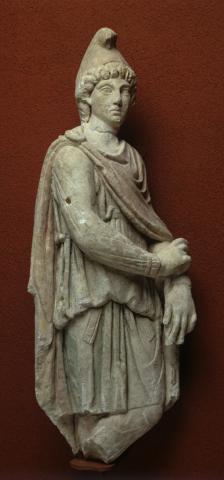Statue of Cautopatès
Cautopatès and Cautès were the two companions of Mithra, the god whose cult was extremely popular throughout the Roman empire from the late 2nd century, and which disappeared during the 4th century due to competition from Christianity.
This cult of eastern origin and with mysteries relating to astrology tended towards monotheism, but it also included initiation rituals and a very special celebration – the sacrifice of a bull followed by a ritual meal. Mithra was honoured in caves or buried sanctuaries, and only men were admitted to the cult. He epitomised light and power, and promoted values such as fraternity, equality and loyalty which made him appreciated by the soldiers, merchants and voyagers who came into contact with the rites that were first adopted in the East.
This limestone statue discovered in 1986 in the Temple of Bordeaux presents Cautopatès in the usual style, dressed in oriental fashion like the god Mithra himself, with a Phrygian cap and cape painted in red. Contrary to his colleague Cautès, who, standing with his legs crossed raises his torch and symbolises light, day and renewal, Cautopatès has his torch lowered, and represents the counterpoint of dusk, autumn and death. These figures would have framed the scene of the sacrifice of the bull by Mithra (tauroctony).

